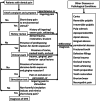Pathogenesis, diagnosis and management of dentin hypersensitivity: an evidence-based overview for dental practitioners
- PMID: 32762733
- PMCID: PMC7409672
- DOI: 10.1186/s12903-020-01199-z
Pathogenesis, diagnosis and management of dentin hypersensitivity: an evidence-based overview for dental practitioners
Abstract
Though dentin hypersensitivity (DHS) is one of the most common complaints from patients in dental clinics, there are no universally accepted guidelines for differential diagnosis as well as selection of reliable treatment modalities for this condition. The neurosensory mechanisms underlying DHS remain unclear, but fluid movements within exposed dentinal tubules, i.e., the hydrodynamic theory, has been a widely accepted explanation for DHS pain. As several dental conditions have symptoms that mimic DHS at different stages of their progression, diagnosis and treatment of DHS are often confusing, especially for inexperienced dental practitioners. In this paper we provide an up-to-date review on risk factors that play a role in the development and chronicity of DHS and summarize the current principles and strategies for differential diagnosis and management of DHS in dental practices. We will outline the etiology, predisposing factors and the underlying putative mechanisms of DHS, and provide principles and indications for its diagnosis and management. Though desensitization remains to be the first choice for DHS for many dental practitioners and most of desensitizing agents reduce the symptoms of DHS by occluding patent dentinal tubules, the long-term outcome of such treatment is uncertain. With improved understanding of the underlying nociceptive mechanisms of DHS, it is expected that promising novel therapies will emerge and provide more effective relief for patients with DHS.
Keywords: Adenosine triphosphate; Dental erosion; Dental pain; Dentin hypersensitivity; Hydrodynamic theory.
Conflict of interest statement
The authors declare there have no competing interests.
Figures


References
-
- Holland GR, Narhi MN, Addy M, Gangarosa L, Orchardson R. Guidelines for the design and conduct of clinical trials on dentine hypersensitivity. J Clin Periodontol. 1997;24(11):808–813. - PubMed
-
- Mantzourani M, Sharma D. Dentine sensitivity: past, present and future. J Dent. 2013;41(Suppl 4):S3–17. - PubMed
-
- Canadian Advisory Board on Dentin Hypersensitivity Consensus-based recommendations for the diagnosis and management of dentin hypersensitivity. J Can Dent Assoc. 2003;69(4):221–226. - PubMed
-
- Dababneh RH, Khouri AT, Addy M. Dentine hypersensitivity - an enigma? A review of terminology, mechanisms, aetiology and management. Br Dent J. 1999;187(11):606–611. - PubMed
Publication types
MeSH terms
LinkOut - more resources
Full Text Sources
Other Literature Sources
Medical
Research Materials

